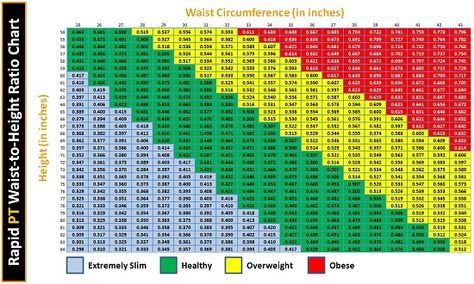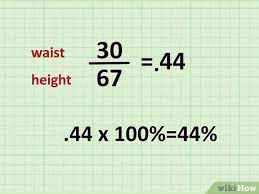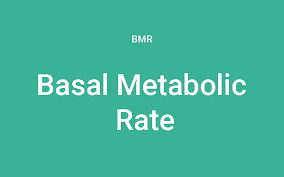Are you in search of reliable tools to assess your overall health and well-being? Look no further! The height to waist ratio calculator (The waist to height calculator) is very important tool that can help you evaluate your health risks associated with abdominal fat.So, let’s embark on this exciting journey of understanding and utilizing it for a healthier, happier life!
Waist to Height Ratio Calculator
Your Waist-to-Height Ratio:
Your Health Status:
| WHtR Value | Health Classification |
|---|---|
| 0.34 and below | Extremely Slim |
| 0.35 to 0.42 | Slim |
| 0.43 to 0.52 | Healthy |
| 0.53 to 0.62 | Overweight |
| 0.63 above | Obese |
[ez-toc]
What is Waist to Height Ratio
Are you looking for a simple yet effective way to assess your health? If so, you're in the right place! In this article, we'll explore the concept of Waist to Height Ratio (WHtR) and why it's becoming increasingly popular among health experts. We'll discuss how to calculate your WHtR, its benefits, and how it compares to other health indicators like BMI. So, let's dive right in and learn more about this essential health metric!
What is Waist to Height Ratio (WHtR)?
Waist to Height Ratio is a straightforward method for evaluating your health based on the relationship between your waist circumference and your height. It is calculated by dividing your waist measurement by your height. WHtR is a more reliable health indicator than traditional metrics like Body Mass Index (BMI) because it focuses on abdominal fat, which is a major contributor to health issues such as heart disease, diabetes, and high blood pressure.
How to Calculate Your Waist to Height Ratio
Calculating your WHtR is quick and easy. Simply follow these steps:
Measure your waist: Using a tape measure, wrap it around the smallest part of your waist, usually just above the belly button. Make sure the tape is snug but not too tight. Record your measurement in inches or centimeters.
Measure your height: Stand straight with your feet together, and measure your height from the top of your head to the floor. Record your measurement in inches or centimeters.
Calculate your WHtR: Divide your waist measurement by your height measurement. For example, if your waist is 32 inches and your height is 64 inches, your WHtR would be 0.50 (32 ÷ 64).
Interpreting Your Waist to Height Ratio - Am I Underweight, Normal Weight, or Overweight?
Once you have calculated your WHtR,Refer to the following guidelines to understand what your WHtR means for your weight category and health:
WHtR of 0.5 or below: This indicates a healthy waist size and suggests that you are within the normal weight range. You are less likely to face health complications related to abdominal fat.
WHtR between 0.5 and 0.6: If your WHtR falls within this range, you may be slightly overweight, with a moderate risk of health issues associated with abdominal fat.
WHtR above 0.6: A WHtR above 0.6 implies that you are overweight and have a higher risk of health problems due to excess abdominal fat. It's essential to make lifestyle changes to reduce your waist size and improve your health.
Please note that while WHtR is a valuable tool for understanding your weight category, it's always best to consult a healthcare professional for a comprehensive assessment of your health.
Shape chart based on waist-to-height-ratio
A Shape Chart based on Waist-to-Height Ratio (WHtR) is a visual representation that helps individuals understand the significance of their WHtR values concerning their health. These charts provide a quick and intuitive way to assess one's risk of health issues related to abdominal obesity. Here's a guide to understanding and using a Shape Chart based on WHtR:
What is a Shape Chart Based on WHtR?
A Shape Chart is a graphical representation of WHtR values and their corresponding shapes or silhouettes. It offers a more intuitive way to interpret WHtR results by associating specific WHtR ranges with different shapes, making it easier for individuals to gauge their health risk.
In our WHtR (Waist-to-Height Ratio) diagram, we've created a straightforward visual tool to help individuals, including both adults and children over 5 years old, assess their health based on waist circumference and height.
Axes and Scale:
The x-axis represents waist circumference, while the y-axis corresponds to height. This user-friendly diagram simplifies the assessment of WHtR.
Color-Coded Zones:
We've divided the diagram into color-coded zones, each offering valuable insights:
Brown to Green (WHtR < 0.4): In this range, indicated in brown, you might be underweight. However, there's no need to decrease your waist circumference. It's essential to consider your overall health, including factors beyond WHtR.
Green (0.4 ≤ WHtR < 0.5): The green zone signifies that you're in good shape concerning your WHtR. This range is considered "OK" and generally suggests a lower risk of health issues related to abdominal obesity.
Green to Yellow (0.5 ≤ WHtR < 0.6): As you move into this range, depicted in yellow, it's a signal to consider taking action if you're an adult. For children, it's a call to take action. While not alarming, this range suggests a moderate risk associated with abdominal obesity.
Yellow to Red (0.6 ≤ WHtR): The red area signifies a need to take action. For adults, it's crucial to consider measures to reduce abdominal obesity. For children, immediate action is recommended. This range is associated with a higher risk of health problems related to abdominal obesity.

Interpreting the WHtR Diagram:
By locating your waist circumference and height on the diagram, you can determine your WHtR and instantly see which zone corresponds to your health status. The color-coded system makes it easy to understand your risk level related to abdominal obesity and whether action is necessary.
Why is Waist to Height Ratio Important? - Benefits of Using Waist to Height Ratio
Waist to Height Ratio (WHtR) is a significant health indicator that offers numerous advantages over traditional metrics like Body Mass Index (BMI). Here are some reasons why WHtR is so important:
Focus on abdominal fat: Unlike BMI, WHtR specifically targets abdominal fat, which is directly linked to numerous health issues, such as heart disease, diabetes, and high blood pressure.
Universal applicability: WHtR is suitable for both men and women, making it a versatile health measurement for everyone.
Simplicity: WHtR is easy to calculate and requires only a tape measure and basic math skills.
Improved accuracy: WHtR is a more reliable predictor of health risks than BMI, as it considers waist size in relation to height rather than relying solely on weight.

Interesting Top Ten Facts on Waist to Height Ratio
The Waist-to-Height Ratio (WHtR) is more than just numbers; it's a key to understanding your health. Here are ten intriguing facts about this powerful metric that can shed light on your well-being.
1. Early Warning System: WHtR is a remarkable early assessment tool for heart disease risk. It provides a quick snapshot of your abdominal obesity, a significant contributor to cardiovascular issues.
2. Complementary Role: While WHtR calculators are indeed valuable, they should be seen as companions to other health measurements and professional medical advice. A holistic approach to health is essential.
3. Apple vs. Pear: The shape of your body can tell a health story. "Apple" shapes, with excess weight around the abdomen, face higher health risks due to abdominal fat proximity to vital organs like the heart, liver, and kidneys.
4. The Pear's Advantage: On the flip side, "Pear" shapes, with more weight around the hips and a narrower waist, enjoy a reduced risk of diabetes, heart disease, and metabolic complications.
5. Improved Accuracy: Experts have endorsed WHtR as a more precise weight measurement than the traditional Body Mass Index (BMI). It pays closer attention to abdominal fat, a crucial health indicator.
6. The Half-Height Rule: A remarkable guideline emerges - if you can maintain your waist circumference at less than half of your height, you significantly reduce your risk of stroke, heart disease, and diabetes.
7. Age Matters: The critical WHtR value varies with age. For those under 40, a WHtR over 0.5 can be a cause for concern. From ages 40 to 50, the critical range extends from 0.5 to 0.6. Beyond 50, a WHtR starting at 0.6 may indicate potential health issues.
8. Morning Accuracy: For the most accurate waist measurements, wake up after 7-8 hours of sleep. Your body's refreshed state can provide the best data for WHtR calculations.
9. Universal Applicability: WHtR transcends age boundaries. It's equally valid for children and adults, regardless of age. However, the specific parameters for waist circumference, height, and WHtR may vary among different races and ethnicities.
10. India's Challenge: India leads the world in diabetes incidence. In this context, WHtR emerges as a potent tool to assess the risk of heart disease. Its simplicity and effectiveness make it a valuable asset in the fight against India's diabetes epidemic.
These ten intriguing facts about the Waist-to-Height Ratio shed light on its importance in assessing health risks. While it's a valuable tool, remember that comprehensive health management should always involve consultation with healthcare professionals and an understanding of individual health factors.
Waist to Height Calculator
Waist to Height Calculator: Unveiling Your Health Status
The waist to height calculator is an essential tool that helps you determine your Waist to Height Ratio (WHtR) by dividing your waist measurement by your height measurement. Like the HtWR, the WHtR is an effective method for evaluating your health risks associated with abdominal fat, offering a more reliable predictor of health risks than BMI.
Using the "waist to height calculator" is straightforward. Input your waist and height measurements, and the calculator will provide your WHtR. Once you have your WHtR, refer to the guidelines outlined earlier in this article to understand the implications for your health and make necessary lifestyle changes.
The Power of Health Metrics: Waist to Height Calculator
Waist to height calculator is a powerful tool that offer numerous benefits for assessing your overall health:
Accurate health assessment: By focusing on abdominal fat, both calculators provide a more reliable predictor of health risks than traditional metrics like BMI.
Easy to use: This calculator requires only your height and waist measurements, making them simple and accessible tools for everyone.
Universal applicability: Waist to height calculator are suitable for both men and women, making them versatile health measurements for everyone.
FAQ
1. What is Waist-to-Height Ratio (WHtR)?
Waist-to-Height Ratio (WHtR) is a health metric that measures the proportion of your waist circumference to your height. It provides insights into your abdominal obesity and health risks.
2. Why is WHtR important for health assessment?
WHtR is crucial because it assesses abdominal obesity, which is linked to various health issues, including cardiovascular disease, diabetes, and metabolic syndrome.
3. What's the ideal WHtR value?
The ideal WHtR varies, but generally, values below 0.5 are considered healthy for adults. However, ideal ranges can differ based on factors like age, gender, and ethnicity.
4. What is a Waist-to-Height Calculator?
A Waist-to-Height Calculator is a tool that helps you determine your WHtR by entering your waist circumference and height. It simplifies the calculation process.
5. How do I use a Waist-to-Height Calculator?
Using a Waist-to-Height Calculator is easy. Enter your waist circumference and height in the provided fields, and the calculator will compute your WHtR.
6. Where can I find a reliable Waist-to-Height Calculator online?
You can find Waist-to-Height Calculators on various health and fitness websites. Ensure you use a reputable and secure source for accurate results.
7. What is a Height-to-Waist Ratio Calculator?
A Height-to-Waist Ratio Calculator is a tool that calculates your WHtR using your height and waist measurements. It offers a quick assessment of your health.
8. How is a Height-to-Waist Ratio Calculator different from a Waist-to-Height Calculator?
Both calculators essentially measure the same WHtR, but they might present the calculation in reverse order. A Height-to-Waist Ratio Calculator may take your height as the input and provide your waist-to-height ratio as the output.
9. Can I use a Height-to-Waist Ratio Calculator for children and adolescents?
Yes, Height-to-Waist Ratio Calculators can be used for people of all ages. However, remember to refer to age-specific guidelines for interpretation and cutoff values when assessing children and adolescents.
10. How often should I calculate my WHtR?
There's no set frequency, but you can calculate your WHtR as needed or during regular health check-ups. It's a useful metric to track changes in abdominal obesity over time.
11. Are there limitations to using WHtR and these calculators?
WHtR is a valuable assessment tool, but it doesn't account for factors like muscle mass, bone density, or individual health conditions. These calculators should be used alongside other health indicators and in consultation with healthcare professionals for a comprehensive health assessment.
12. What should I do if my WHtR is in a higher-risk range?
If your WHtR falls into a higher-risk range, consider adopting a healthier lifestyle. This may include a balanced diet, regular physical activity, and stress management. Consulting with a healthcare professional or a registered dietitian can provide personalized guidance and strategies for improvement.
Conclusion
Waist to height calculator are essential tools that can help you evaluate your health risks associated with abdominal fat. By utilizing these calculators, you can make informed decisions about your lifestyle and take control of your well-being. Don't wait any longer – harness the power of these calculators and unlock the secrets of your health today!





